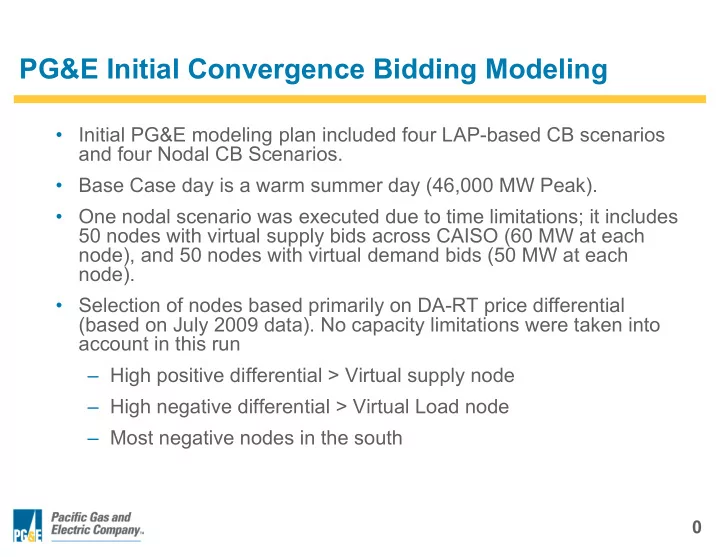

PG&E Initial Convergence Bidding Modeling • Initial PG&E modeling plan included four LAP-based CB scenarios and four Nodal CB Scenarios. • Base Case day is a warm summer day (46,000 MW Peak). • One nodal scenario was executed due to time limitations; it includes 50 nodes with virtual supply bids across CAISO (60 MW at each node), and 50 nodes with virtual demand bids (50 MW at each node). • Selection of nodes based primarily on DA-RT price differential (based on July 2009 data). No capacity limitations were taken into account in this run – High positive differential > Virtual supply node – High negative differential > Virtual Load node – Most negative nodes in the south 0
PG&E Initial Convergence Bidding Modeling • None of the Nodal CB runs achieved AC convergence; the selection of the nodes in the lower kV system along with capacity limitations is probably the reason for the divergence. Additional tests are required to draw solid conclusions. These results are very preliminary. • Three of four LAP CB runs achieved AC convergence. These conclusions are based on sufficient testing. In the divergent case the AC Power Flow did not converge for 5 hours • The reason for the divergence was that in CB bids created injections that resulted in transmission line overloads. These overload resulted in substantially reduced voltages that caused the AC power flow to diverge 1
Possible Next Steps – PG&E Convergence Bidding Modeling • Test AC Power Flow convergence sensitivity and "Break Point" for Nodal Convergence Bidding: – Sensitivity to nodal MW levels. – Sensitivity to total MW levels. – Sensitivity of geographical distribution of virtual bids. – Sensitivity of voltage distribution of virtual bids. • Develop scenarios to quantify LAP-load arbitrage impact: – Introduce DA LDF errors and virtual bids to mitigate. – Measure impacts to physical supply, physical load and virtual traders. – Complicated modeling and input development. • Confirm CAISO scenario analysis (requires the CAISO to share key inputs such as Virtual Bid set). • This additional modeling will take several months to complete. 2
Recommend
More recommend